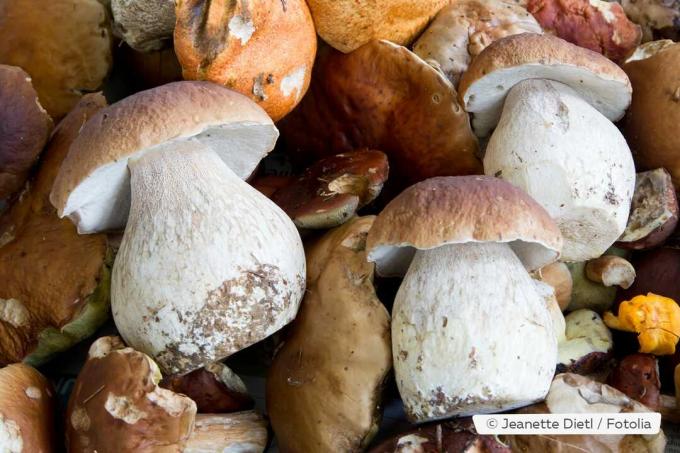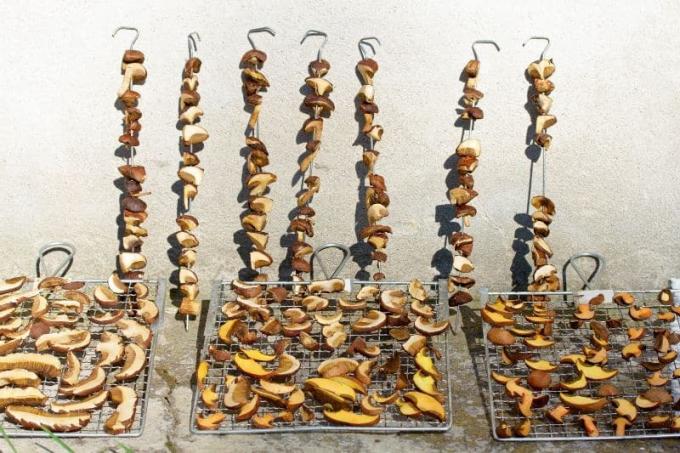
Sometimes the mushroom harvest falls like this lushthat drying is the space-saving method of preserving them. To do this, the mushrooms must be properly prepared so that they do not become moldy during the drying process.
To the point
- Before drying, clean the mushrooms and cut them into smaller pieces or slices
- The quickest way to dry is in the oven or dehydrator
- Turn mushrooms regularly when air drying
- Freeze drying is the gentlest method
- at approx. Dry at 70°C
Table of contents
- Prepare mushrooms
- Drying mushrooms in the oven
- Air dry mushrooms
- Dry mushrooms in the dehydrator
- Freeze drying
- Inappropriate drying methods
- frequently asked Questions
Prepare mushrooms
So that you Mushrooms To dry, they must be cleaned of dirt and checked for maggots.

Clean mushrooms properly:
- Remove loose dirt with a small, medium-strength brush
- Use a small knife to carefully scrape off any solid dirt
- Cut away feeding spots
Never use water to clean. If the mushrooms are moist on the surface, you can carefully pat them dry with a kitchen paper towel. If the mushrooms are too moist, there is a high risk that they will start to mold.
A bristle brush is ideal for cleaning. The bristles are firm and it has the ideal width so that you can easily reach all areas, even with small mushrooms.

Then cut the cleaned mushrooms into slices or small pieces. Small pieces are ideal if you want to process the mushrooms directly into a powder because they dry faster. You should make slices if you plan to rehydrate the mushrooms later. Whether at Sponge fungi The sponge also has to be removed, opinions differ. For older specimens, it is always advisable to remove the sponge, as maggots may already have nested there.
Drying mushrooms in the oven
The first method is drying in the oven, which anyone can easily do at home. Drying works with devices with circulating air as well as with top and bottom heat. However, with circulating air it is much faster.
Instructions for drying in the oven:
- Line the baking tray with baking paper
- Spread the mushrooms on top in a thin layer
- Set the oven to 50 to 70 °C
- Leave the door slightly open (clamp the tablespoon)
- Turn mushrooms every 1 to 2 hours

With top/bottom heat you can increase the temperature by approx. Increase 10°C. To achieve a more even result, you should also turn the mushrooms more often.
Air dry mushrooms
Drying in the air saves energy. The mushrooms can be left in the sun, which means they dry out more quickly.
Air drying instructions:
- Spread the mushrooms evenly on a wire rack
- Place the rack in the sun or partial shade
- Make sure there is sufficient ventilation from below
- Turn mushrooms at least daily until completely dry

Dry mushrooms in the dehydrator
If you have an automatic dehydrator, you can easily dry the mushrooms in it.
Instructions for drying in the dehydrator:
- Spread mushrooms in a thin layer
- Set the machine to a maximum of 70 °C
- Alternate layers for a more even result

As with drying on the wire rack, the mushrooms can also stick to the bottom of the dehydrator. You can prevent this by lining the bases with baking paper. However, make sure that the air can still circulate well so that the mushrooms dry evenly and the device does not overheat.
Freeze drying
Freeze drying is only possible with a suitable device. The investment costs are high, but worthwhile if food is often dried for preservation. The advantage of freeze-drying is that the aroma is retained much better. This means that the mushrooms can be stored for longer and are visually more beautiful.
Inappropriate drying methods
Not every method is suitable for drying. People often try to save money in the wrong corners and mushrooms are, for example, placed on baking trays on the dashboard of cars. The interior of vehicles can heat up to well over 80 °C if left in the sun for a long time, which would be too hot for the fungi. In addition, the bacterial load inside vehicles is high and the fungi could be contaminated by the increased humidity in the vehicle.

Drying mushrooms on strings is only suitable to a limited extent. The mushrooms or Mushroom pieces threaded onto threads and hung up. The disadvantage here is the thread, which can absorb humidity. The mushrooms around the thread often take longer to dry. They can also curl up or fold in, causing the pieces or slices to not dry evenly. This means that pieces can quickly be overlooked that are not completely dry and will later start to mold in storage containers.
frequently asked Questions
Yes, some mushrooms can become tough or have little flavor when dried. For example, they are not suitable for drying Chanterelles, which are better preserved frozen. Drying is also not a suitable method of preservation for Egerlings, irrigants or gray caps.
Yes, dried mushrooms can be of food moths be attacked. Therefore, you should store the dried mushrooms in airtight containers or vacuum seal them in portions. When you pack in portions, you have the advantage that if there is a storage pest in the package, only one package will be infected and not the entire mushroom supply.
If the mushrooms are dried and stored correctly, the mushrooms will last forever. It may happen that they no longer look as good after a while, but the taste remains the same. If necessary, you can dry mushrooms in pieces and process them into a powder later if they no longer look so attractive.


